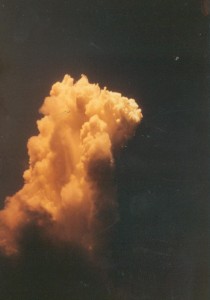The environmental and health consequences of radiation released after explosions at several Japanese reactors in Japan will be felt for generations to come in Japan, the region, and the globe. This photograph from May 1962 is probably from the Dominic I atomic tests on Christmas Island.

It is part of the Atomic Veterans Collection at DCA which, given the events in Japan, contains highly relevant material. The collection documents long-term human and environmental costs of radiation regarding atomic tests, waste disposal and nuclear energy, it traces health effects and law suits for compensation. The collection includes correspondence, secondary print and audio-visual material, interviews with atomic veterans, and photographs. It was donated to DCA by Sandra Kane Marlow in honor of Colonel Nicholas Kane, the founder of The National Association of Atomic Veterancs (NAAV), and all atomic veterans. Ms. Marlow was affiliated with NAAV and founded the Center for Atomic Radiation Studies in Boston.
Since 1979, NAAV has been assisting veterans in obtaining government recognition and Department of Veterans' Affairs health care and financial assistance. Atomic veterans include over a million US servicemen and civilian personnel who, participating in and witnessing detonations at various Pacific and Nevada test sites, were exposed to ionizing radiation beginning with the Trinity Blast of July 16, 1945 at Alamogordo, New Mexico and ending with the Nuclear Test Ban Treaty of 1963. Most detonations emitted considerably more radiation than the atomic bombings of Hiroshima and Nagasaki in 1945. US government agencies and departments wanted to learn about the effects of atomic and nuclear weapons and how they affected the immediate performance of military personnel and equipment. Troops, ships, and equipment were placed from several hundred yards to several miles from the center of each detonation. On many occasions military personnel performed maneuvers in and around ground zeros without protective clothing or respiratory devices.
Since the test ban of 1963, there has been no government sponsored medical surveillance of test participants, nor any effort to locate these individuals to warn them of potential health risks. The few individuals located through NAAV's efforts have been found to have unusually high incidents of various types of cancer and other associated diseases and health problems with their children







